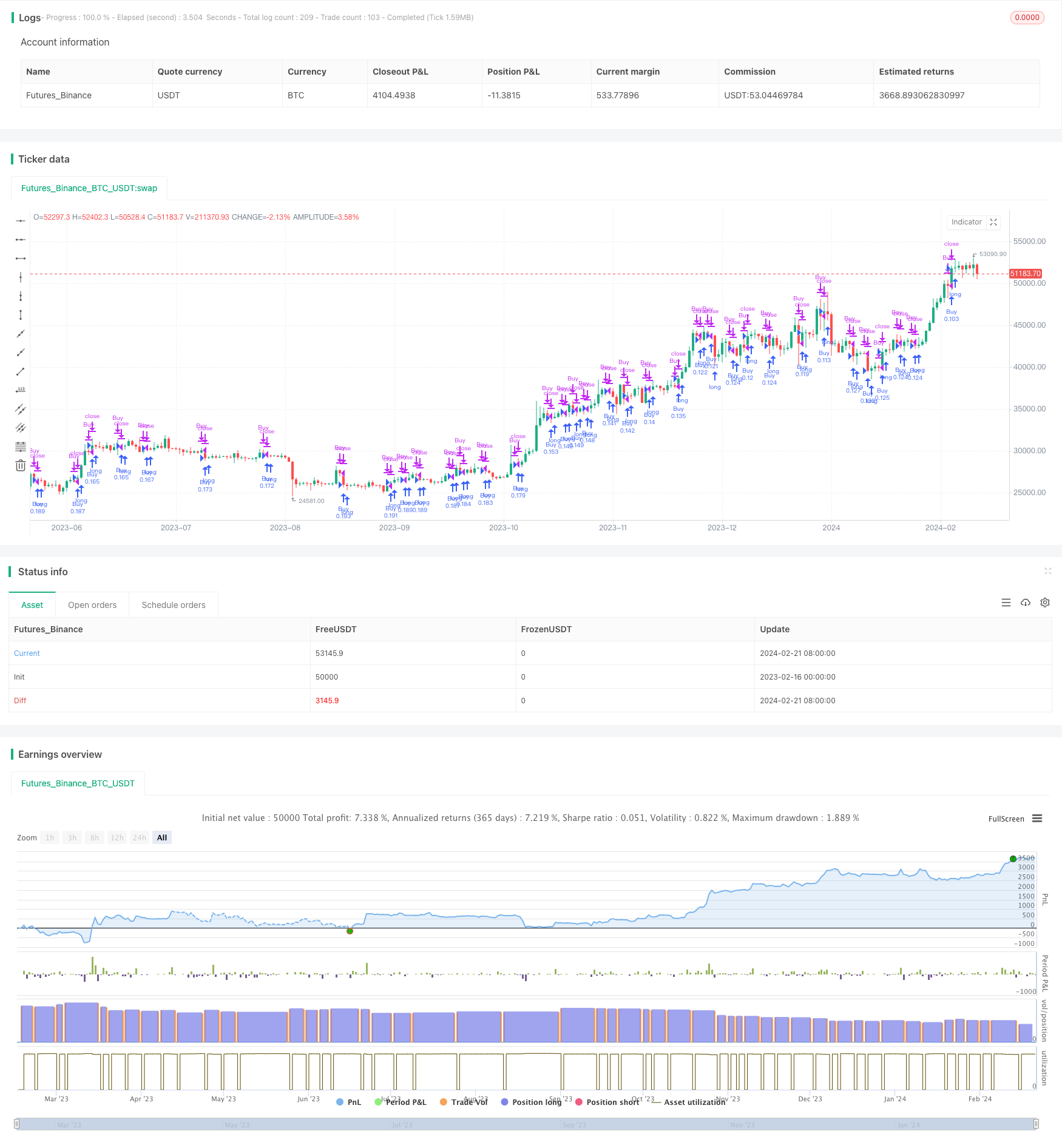
Overview
This strategy combines Dollar Cost Averaging (DCA) with the trailing take profit feature available on exchange platforms. It sets a 1% price deviation for purchases and targets 0.5% profit on each sale. The rationale for targeting small profits is to ensure smooth operations for the trading bot, avoiding getting stuck during slow market periods. Based on backtesting, this bot has proven to be adaptable enough to withstand market fluctuations and manipulation. While the Annual Percentage Rate (APR) may not be exceptionally high, it offers a satisfactory and secure option for long-term investment, often outperforming the traditional buy and hold (HODL) strategy.
Principles
The strategy first sets configurable parameters like trailing stop percentage, max DCA orders, price deviation percentage, etc. It then tracks variables like last buy price, number of buys, initial buy price, trailing stop price, etc. On the buy logic, if the current price is below the last buy price * (1 - price deviation percentage) and the number of buys has not reached max DCA orders, it will issue a buy signal and record the buy price. On the sell logic, if the current price is above the last buy price * (1 + take profit percentage), it will set a trailing stop price. If the price continues to rise above that trailing stop price, the trailing stop is updated to current price * (1 - trailing percentage). If the price drops below the trailing stop price, a sell signal is issued while resetting relevant variables, getting ready for the next round of DCA buys.
Advantages
Combines DCA and trailing stop loss to ensure cost averaging while locking in partial profits to avoid drawdowns.
Flexible trailing stop mechanism with adjustable profit taking and trailing percentage to minimize risk.
Backtested results outperform buying and holding, with steady annualized returns suitable for long-term investments.
Simple to implement with adjustable parameters for easy application across major exchange platforms.
Risks
Limited number of DCA buys means losses can compound if market trends down for extended periods.
Poor trailing stop loss settings may lead to premature profit taking or runaway losses.
Trading costs can eat into profits. High trailing stop loss settings increase number of trades.
Requires sufficient capital to support frequent DCA buys. Insufficient initial capital limits number of buys.
Enhancements
Implement adaptive trailing stops, lowering trailing percentage as certain profit milestones are reached.
Incorporate moving averages, increasing buy amounts around key support areas.
Add rebalancing mechanism to adjust DCA amounts based on total assets.
Optimize parameter settings and test profitability across various holding periods.
Conclusion
This strategy combines DCA and trailing stops for steady algorithmic trading returns over long periods. Backtested results are strong and suitable for investors focused on stable growth. Simple and clean code makes it easy to understand and implement. Further performance gains can be achieved through parameter optimization and incorporating additional indicators. Overall it provides investors with a relatively safe and consistent quantified trading solution.
/*backtest
start: 2023-02-16 00:00:00
end: 2024-02-22 00:00:00
period: 1d
basePeriod: 1h
exchanges: [{"eid":"Futures_Binance","currency":"BTC_USDT"}]
*/
// This Pine Script™ code is subject to the terms of the Mozilla Public License 2.0 at https://mozilla.org/MPL/2.0/
// © Stavolt
//@version=5
strategy("DCA Strategy with Trailing Take Profit", overlay=true, initial_capital=1000, default_qty_type=strategy.percent_of_equity, default_qty_value=10)
// Correctly using input to define user-configurable parameters
takeProfitPercent = input.float(0.6, title="Take Profit (%)", minval=0.1, maxval=5)
trailingPercent = input.float(0.1, title="Trailing Stop (%)", minval=0.05, maxval=1)
maxDCAOrders = input.int(10, title="Max DCA Orders", minval=1, maxval=20)
priceDeviationPercent = input.float(1.0, title="Price Deviation (%)", minval=0.5, maxval=5)
var float lastBuyPrice = na
var int buyCount = 0
var float initialBuyPrice = na
var float trailingStopPrice = na
// Strategy logic here...
// Note: The detailed logic for buying and selling based on the DCA strategy
// needs to be tailored to your specific requirements and tested for correctness.
if (buyCount < maxDCAOrders)
if (na(lastBuyPrice) or close < lastBuyPrice * (1 - priceDeviationPercent / 100))
strategy.entry("Buy", strategy.long)
lastBuyPrice := close
buyCount += 1
if (na(initialBuyPrice))
initialBuyPrice := close
if (not na(lastBuyPrice) and close > lastBuyPrice * (1 + takeProfitPercent / 100))
if (na(trailingStopPrice) or close > trailingStopPrice)
trailingStopPrice := close * (1 - trailingPercent / 100)
if (close < trailingStopPrice)
strategy.close("Buy")
lastBuyPrice := na
trailingStopPrice := na
buyCount := 0
initialBuyPrice := na